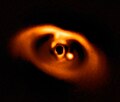| Observation data Epoch J2000 Equinox J2000 | |
|---|---|
| Constellation | Dorado [1] [2] |
| Right ascension | 06h 28m 22.97s [3] |
| Declination | −65° 34′ 43.01″ [3] |
| Apparent magnitude (V) | 13.10±0.01 [4] |
| Characteristics | |
| Evolutionary stage | Main sequence |
| Spectral type | M2V [4] |
| Astrometry | |
| Radial velocity (Rv) | −4.4±0.1 [4] km/s |
| Proper motion (μ) | RA: −102.750±0.051 [5] mas/yr Dec.: 161.805±0.060 [5] mas/yr |
| Parallax (π) | 32.0980±0.0211 mas [5] |
| Distance | 101.61 ± 0.07 ly (31.15 ± 0.02 pc) |
| Details | |
| Mass | 0.416 ± 0.010 [4] M☉ |
| Radius | 0.420 ± 0.031 [4] R☉ |
| Luminosity | 0.0233 ± 0.0011 [4] L☉ |
| Surface gravity (log g) | 4.81 ± 0.06 [4] cgs |
| Temperature | 3480 ± 135 [4] K |
| Metallicity [Fe/H] | −0.07 ± 0.11 [4] dex |
| Rotation | 54.0 ± 0.8 [4] d |
| Age | >1.5 [4] Gyr |
| Other designations | |
| TIC 150428135, UCAC3 49-21611, 2MASS J06282325-6534456, WISE J062823.05-653443.7, APASS 31812705, Gaia DR2 5284517766615492736 | |
| Database references | |
| SIMBAD | data |
TOI-700 is a red dwarf 101.4 light-years away from Earth [3] [5] located in the Dorado constellation that hosts TOI-700 d, the first Earth-sized exoplanet in the habitable zone discovered by the Transiting Exoplanet Survey Satellite (TESS). [1] [2] [6]








